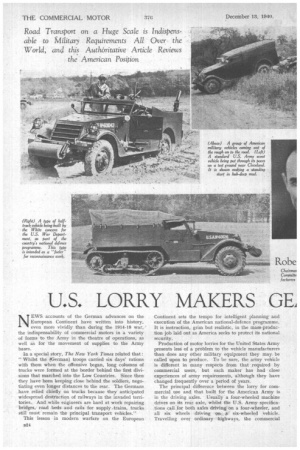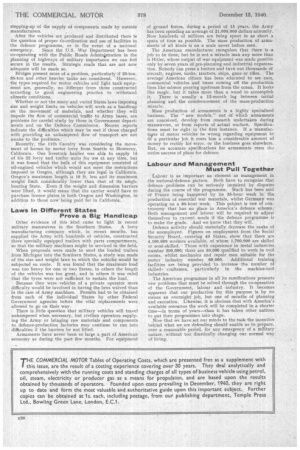U.S. LORRY MAKERS GE UP TO DEFENCE NEEDS
Page 30

Page 31

Page 32

If you've noticed an error in this article please click here to report it so we can fix it.
NEWS accounts of the German advances on the European Continent have written into history, even more vividly than during the 1914-18 war, the indispensability of commercial motors in a variety of forms to the Army in the theatre of operations, as well as for the movement of supplies to the Army bases.
In a special story, The New York Times related that : " Whilst the (German) troops carried six days' rations with them when the offensive began, long columns of trucks were formed at the border behind the first divisions that marched into the Low Countries. Since then they have been keeping close behind the soldiers, negotiating even longer distances to the rear. The Germans have relied chiefly on trucks because they anticipated widespread destruction of railways in the invaded territories., And while engineers are hard at work repairing. bridges,road beds and rails for supply ,trains, trucks still 'mist remain the principal transport vehicles."
This lesson in modern warfare on the European Continent sets the tempo for intelligent planning and execution of the American national-defence programme. It is instruction, grini but realistic, in the mass-production job laid out as America seeks to protect its national security.
Production of motor lorries for the United States Army presents less of a problem to the vehicle manufacturers than does any other military equipment they maybe called upon to produce. To be sure, the .arrny vehicle is different in many respects from. that required by commercial users, but each maker has had close experiences of army requirements, although they have changed frequently over a period of years.
The principal difference between the lorry for commercial use and that built for the American Army is in the driving axles. Usually a four-wheeled machine drives on its rear axle, whilst the U.S. Army specificaAims call for both axles driving on a four-wheeler, and all six wheels driving on; a' six-wheeled vehicle. Travelling over Ordinary highways, the commercial
motor rarely wants the power needed by vehicles that are called upon to make cross-country journeys over shell-torn areas, where one wheel may be required to have enough traction to start the machine on its way.
The front driving axle that meets Army specifications has been perfected by one company, but with the current scale of military requirements it will be necessary to increase the supply considerably-, if a bottle-neck is to be avoided. Army engineers, working in conjunction with the automobile industry, have as their objective a maximum degree of standardization and interchangeability of components.
Not only may the defence programme increase production of army lorries, but the commercial use of vehicles may expand, as has been the case in recent months. Increased utilization of the existing4,500,000 commercial vehicles now operating may intensify the replacement Aemand and the expansion of plant for armament output may create the need for additional road-transport facilities
How well are American manufacturers equipped to supply civilian as vvell as military requirements? That depends on the extent of the demand. The five highest output years for American commercial vehicles were as follow :-1929, 771,020; 1935, 694,690; 1936, 784,587; 1937, 899,085; 1939, 710,496.
In none of these years was peak production-capacity approached. The plants turned out 75,000 lorries a month during March and April of this year, working single eight-hour shifts on a five-day week.. • In excess of a million lorries can be• turned off the lines without taxing capacity too heavily.
There are, of. course, other factors which enter into this picture. One is that army specifications lutist not be changed from time to time to the point at which a drastic . re-tooling job. is required. Another is that the transportation agencies must be geared to adjust the• flow of raw materials aact parts .iuto the factories, according to production khedules. Most vital is the
stepping-up of the supply of components made by outside manufacturers,
After the vehicles are produced and -distributed there is the question of proper do-ordination and use of facilities in the defence programme, or in the event of a national
emergency. Since the U.S. War Department has been co-operating with the Public Roads Administration in the planning of highways of military importance we can feel secure in the results. Strategic roads that are not now adequate will be made so.
Bridges present more of a problem, particularly if 20-ton, 95-ton and 4)the r heavier tanks are considered. However, the types required for motor vehicles and light tank equipment are, generally, no different from those constructed according to good engineering practice to withstand climatic conditions.
Whether or not the many and varied States laws imposing size and weight limits on vehicles will work as a handicap on the movement of materials, and whether they will impede the flow of commercial traffic to Aimy bases, are problems for careful study by those in Government departments and on the Defence Commission. Recent reports indicate the difficulties which may be met if those charged with providing an unhampered flow of transport are not awake to the problems:
Recently, the 11th. Cavalry was considering the movement of horses by motor lorry from Seattle to Monterey, California.One livestock haulier was able to supply 15 of his 22 lorry and trailer units for use at any time, but it was found that the bulk of this equipment consisted of oil-engined vehicles which would not meet the restrictions imposed in Oregon, although they are legal in California. Oregon's maximum length is 10 ft. less and its maximum weight limit considerably lower than that of its neighbouring State. Even if the weight and dimension barriers were lifted, it would mean that the carrier would have to purchase licence plates in both Oregon and Washington, in addition to those now-being paid for in California.
Laws in Different States Prove a Big Handicap
Other evidence of this kind came to light in recent military manceuvres in the Southern States. A lorry manufacturing company which, in recent months, has supplied the Army with hundreds of vehicles, constructed three specially equipped trailers with parts compartments, so that the military machines might be serviced in the field, When proposals were made to send the loaded trailers from Michigan into the Southern States, a study was made of the size and weight laws to which the vehicles would be subjected en route. It was found that the maximum load was too heavy for one or two States, in others the length of the vehicles was too great, and in others it was ruled that the tyres were not sufficient to sustain the load, Because they were vehicles of a private operator more difficulty would be involved in having the laws waived than in the case of Army machines. Permits had to be obtained from each of the individual 'States by other Federal Government agencies before the vital replacements were allowed to go on their way.
There is little question that .military vehicles will travel unhampered when necessary, but civilian operators supplying the Army or bringing raw materials and components to defence-production factories may continue to run into difficulties if the barriers be not lifted.
Armaments have never been so large a part of American economy as during the past few months. For equipment
of ground forces, during a period of 15 years, the Army has been spending an average of 21,000,000 dollars annually. Now hundreds of millions are being spent in as short a space of time as possible. The mass production of arrnaments of all kinds is on a scale never before seen.
The American manufacturer recognizes that there is ,a job to be done, but he is not a miracle man any more than
is Hitler, whose output of war equipment was made possible only by seven years of pre-planning and industrial organization. Nobody can press a button and turn out thousands of aircraft, engines, tanks, tractors, ships, guns or rifles. The average American citizen has been educated to see cars, commercial vehicles and buses coming off the production lines like salmon pouring upstream from the ocean. It looks. like magic, but it takes more than a wand to accomplish it. There is usually a 12-month lag between initial planning and the commencement of the mass-production miracle, .
Mass production of armaments is a highly specialized business. The " new models," out of which armaments are conceived, develop from research undertaken during
manceuvres, or from reports of actual warfare. Specifications must be right in the first instance. If a. manufac tuirer of motor vehicles be wrong regarding equipment to fit a particular job it costs him a considerable amount of money to rectify his error, or the business goes elsewhere. But, on accurate specifications for armaments rests th.i entire success of plans for defence.
-Labour and Management Must Pull Together
• Labour is as important an element as management in
the national-defence picture. Both have to recognize that defence problems can be seriously impaired by disputes during the course of the programme. Much has been said of France being hampered by its 35-hour week in the production of essential war materials, whilst Germany was operating on a 60-hour week. This subject is one of controversy that has no place in America's defence scheme:. Both management and labour will be required to adjust themselves to current needs if the defence programme is to make the grade. And we know that they will.
Defence activity should materially decrease the ranks of the unemployed. Figures on employment from the Social Security Board, .covering 43Stales, show that there are 4,100,000 workers available, of whom 1,700,000 are skilled or semi-skilled. Those with experience in metal industries number 200,000; there are 50,000 qualified to work in tool rooms, whilst mechanics and repair men suitable for the motor industry number 60,000. Additional training, facilities are being provided to increase the number of craftsmen, particularly in the machine-tool industries.
The American programme in all its ramifications presents new problems that must he solved through the co-operation of the Government, labour and industry. It becomes apparent that our production for this purpose is by no means an overnight job, hut one of months of planning and execution. Likewise, it is obvious that with America's available resources the work will be completed in a shorter time—in terms of years—than it has taken other nations to put their programmes into shape. Now that we have set our minds to the task the incentive behind what we are defending should enable us to prepare, over a reasonable period, for any emergency of a military: nature, without too drastically changing our normal way of living.




























































